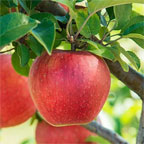- Q.Fig Growing - I have one fig tree, that when planted a few years ago, had one fig on it. Since then, although ...
- Q.Fig Cultivation - I live in the Willamette Valley of Oregon. My fig tree produces in the summer, then produces a large quantity ...
- Q.Fig Tree: Spots On Leaves - Our fig tree is in a container. It is a few months old. The leaves have developed brown, rusty-looking spots ...
- Q.Fig Trees - Three years ago I planted two different types of fig trees in the same area. (within two feet of each ...
- Q.Fig Tree Leaves Browning - How do I stop this problem? I have got two trees from a friend and lots of leaves are falling ...
- Q.Topping A Fig Tree When Pruning… - We moved into a mobile home in Feb 2009. There is a fig tree that we trimmed way back at ...
- Q.Trimming Fig Tree - How do you trim a newly planted bare root fig tree that has no limbs?
Q.Fig Growing
I have one fig tree, that when planted a few years ago, had one fig on it. Since then, although it has luxurious leaves (and plenty of them), nary a sign of figs. It has plenty of light, although it is planted in a clay-type soil, and the drainage is not the best.
- A.
There can be a number of factors that inhibit fig fruiting. This article will help you: https://www.gardeningknowhow.com/edible/fruits/figs/fig-tree-is-producing-fruit.htm
Was this answer useful?00
Q.Fig Cultivation
I live in the Willamette Valley of Oregon. My fig tree produces in the summer, then produces a large quantity of small sized, inedible green figs that fall onto the ground. They are inedible. I have not fertilized or watered the tree so wonder if it's related to that. What's up?
- A.
This article will help you: https://www.gardeningknowhow.com/edible/fruits/figs/fig-drop.htm
Was this answer useful?00 Q.Fig Tree: Spots on Leaves
Our fig tree is in a container. It is a few months old. The leaves have developed brown, rusty-looking spots on them. The spots are not raised.
- A.
It sounds like your tree has developed Fig Rust. This article will help: https://www.gardeningknowhow.com/edible/fruits/figs/figs-disease-rust.htm
Was this answer useful?00 - A.
I do a solid watering once the top 3 inches are dry. It currently stands by a small window with south exposure, and lots of non direct light. Can't seem to figure it out.
Was this answer useful?00 Q.Fig Trees
Three years ago I planted two different types of fig trees in the same area. (within two feet of each other) One plant was from my brothers trees in Mississippi, type unknown. The other came from Wal Mart and was a dark Texas type. The one from my brother has produced figs for the last two years while the second has yet to produce any figs. My guess is that I need a second plant of the same kind to get figs on the second plant. Thanks for the info.
- A.
Most fig trees need to be 2-4 years old before they can produce fruit. I would say that your Texas variety needs a few more years before it is mature enough. The one from your brother's home may have been older when you got it or it may have come from a cutting from more mature wood or it is simply a variety that has less time to full maturation.
For the one that it not producing, I would give it another year or so. Just in case, I would give it a bit of bone meal. Figs are very susceptible to too much nitrogen, which can produce lots of foliage and little fruit. Bone meal will provide phosphorus, which helps boost fruit production.
Was this answer useful?10 Q.Fig Tree Leaves Browning
How do I stop this problem? I have got two trees from a friend and lots of leaves are falling off. The soil seemed to be very dry when I got them, too.
- A.
If the soil was very, very dry when you got the plants, the soil may be resisting taking up water. Fill your tub or a large bucket with water and place the plants in the water and let them sit for about an hour. This will force the over dry soil to once again take up water and should help with the leaves falling off.
Was this answer useful?10 Q.Topping a Fig Tree When Pruning…
We moved into a mobile home in Feb 2009. There is a fig tree that we trimmed way back at that time. This summer it GREW a lot! It is regulation in this park that the trees cannot be highter than our mobile home. So we see no other alternative but to "top it". The tree is just too big for the area. It had a lot of messy fruit. We don't eat figs. What should we do?
- A.
Fig trees do fine being heavily pruned, so that is not a problem. Prune as you need to. It will likely encourage the plant to grow more like a shrub though, depending on how big it is already.
Pruning it in the spring after new growth appears will help reduce the amount of fruit it produces. You can also call local food banks. Some have programs where extra fruits and vegetables can be donated. Some food banks will even come and collect the fruit from the tree for you.
Was this answer useful?10 Q.Trimming Fig Tree
How do you trim a newly planted bare root fig tree that has no limbs?
- A.
You should always wait for newly planted trees to establishe themselves before attempting to prune. Generally, this can take up to a year. During this time the tree is putting all of its energy into growing roots, which is imperative for healthy growth. If you try to prune before your fig is established, it will simply revert this energy to healing itself, rather than growing roots, making it more susceptible to pests and disease.
Was this answer useful?11



